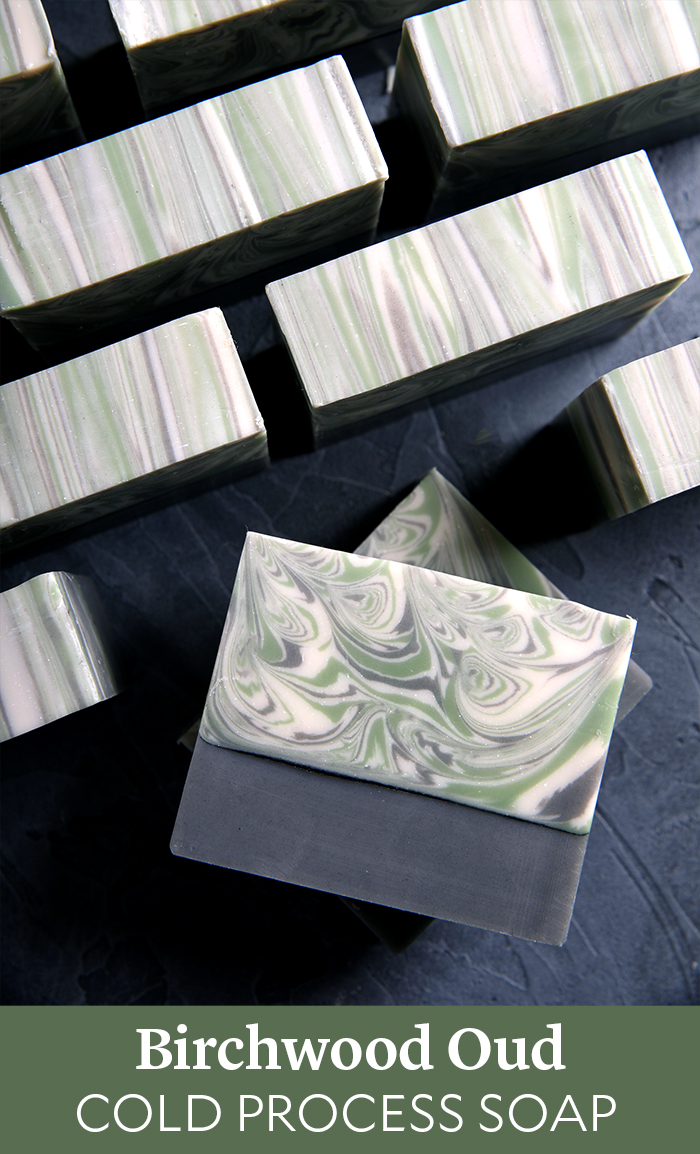
Birch trees are known for their beautiful white trunks. The colors and textures of those trees, along with new Birchwood Oud Fragrance Oil, inspired this cold process soap. These bars feature two layers separated by a line of activated charcoal. The bottom half is colored with activated charcoal and the top layer is made using the Clyde Slide technique. If you’re an advanced soaper ready for a challenge, this project is for you.
This recipe contains several luxurious oils including jojoba oil, chia seed oil, and lingonberry seed oil. Coconut oil and palm oil add cleansing properties and firmness to the bars. Olive oil is moisturizing and slows down trace, which allows for the complicated swirl on top.
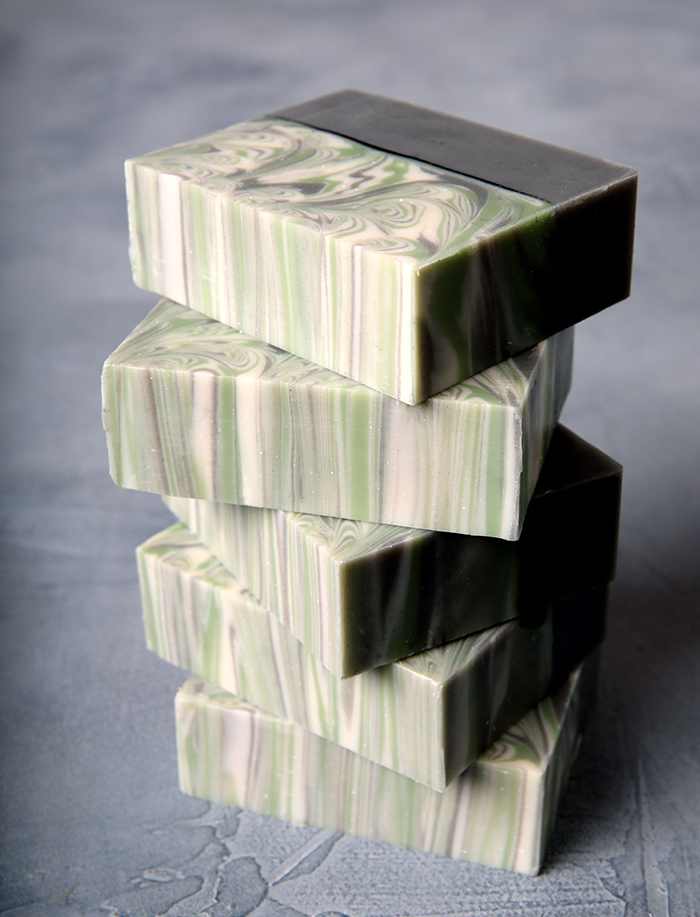
The Clyde Slide technique was made popular by Clyde Yoshida of Vibrant Soap. It involves layering soap into a large bowl and then pouring it in the mold. It can result in very different swirls depending on the number of layers, the thickness of trace, and how the soap is poured into the mold. We recommend always using a well-behaving fragrance oil for this technique, and be ready to work quickly but carefully.
Check out the winners from Amy Warden’s Clyde Slide challenge several years ago to see the wide range of swirls that can be created with the technique. We love how each bar looks so different!
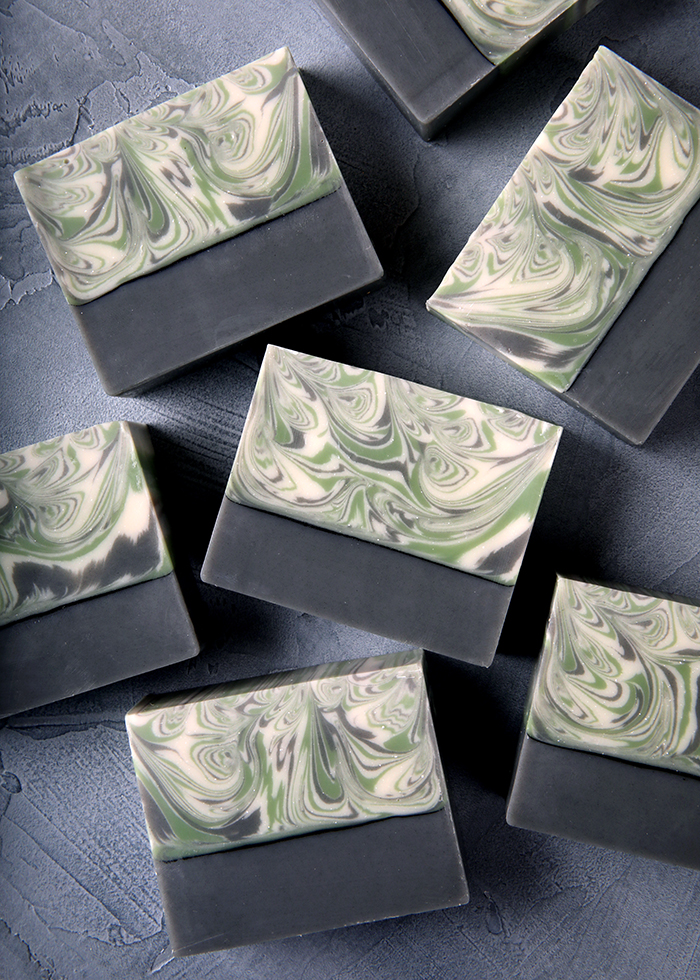
What You Need: Click below to add everything you need for this project to your Bramble Berry shopping cart!Birchwood Oud Cold Process Soap
5 Pound Mold with Sliding Bottom
Silicone Liner for 5 lb. Wood Mold
13.8 oz. Coconut Oil (25%)
2.8 oz. Jojoba Oil (5.1%)
5.5 oz. Lingonberry Seed Oil (10%)
2.8 oz. Chia Seed Oil (5%)
16.5 oz. Olive Oil (29.9%)
13.7 oz. Palm Oil (24.9%)
7.6 oz. Sodium Hydroxide Lye
16.4 oz. Distilled Water (10% water discount)
3.5 oz. Birchwood Oud Fragrance Oil
Titanium Dioxide
Activated Charcoal
Green Chrome Oxide Pigment
Evergreen Mica
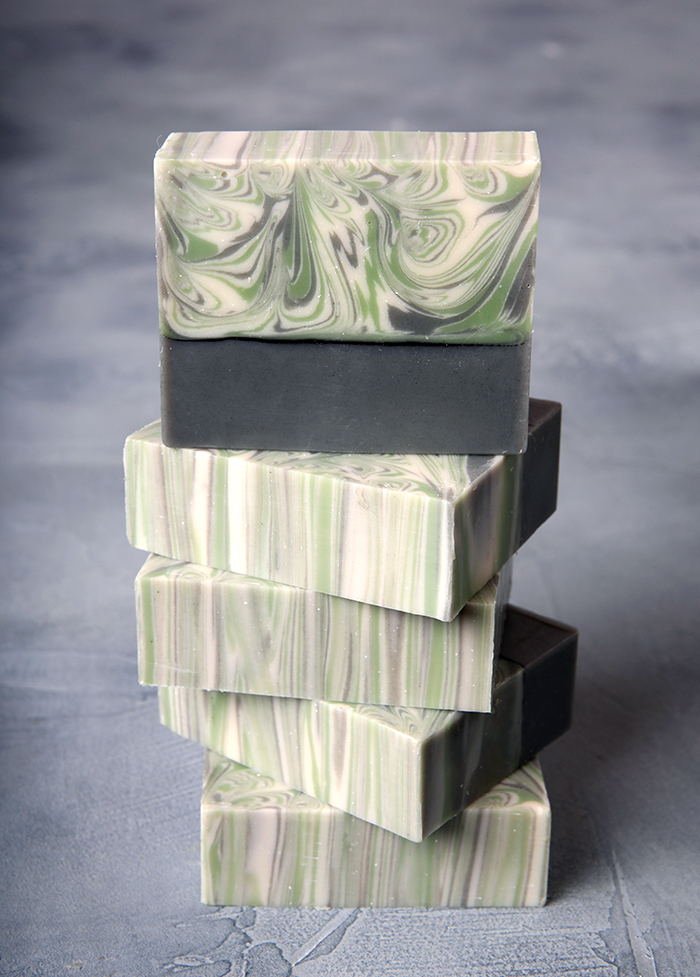 If you’ve never made cold process soap before, stop here. We highly recommend checking out our FREE four part SoapQueen.tv series on cold process soapmaking, especially the episode on lye safety. And if you’d rather do some reading, Bramble Berry carries a wide range of books on the topic, including Pure Soapmaking.
If you’ve never made cold process soap before, stop here. We highly recommend checking out our FREE four part SoapQueen.tv series on cold process soapmaking, especially the episode on lye safety. And if you’d rather do some reading, Bramble Berry carries a wide range of books on the topic, including Pure Soapmaking.
COLORANT PREP: Disperse 1 teaspoon of titanium dioxide into 1 tablespoon of a lightweight liquid oil such as sunflower or sweet almond. In separate containers, disperse 1/2 teaspoon Green Chrome Oxide Pigment and 1/2 teaspoon Evergreen Mica into 1/2 tablespoon of lightweight liquid oil. Finally, disperse 1 teaspoon of activated charcoal into 1 tablespoon of lightweight oil. Use a mini mixer to get rid of clumps.
Optional: To ensure the titanium dioxide blends smoothly into the soap, we recommend micronizing it before dispersing it in oil. Use a coffee grinder to break up any clumps of color and prevent streaks of white from showing in the final soap. We like to use a coffee grinder that has a removable stainless steel mixing area for easy cleaning.
FRAGRANCE PREP: In a glass fragrance oil-safe container, measure out 3.5 ounces of Birchwood Oud Fragrance Oil and set aside.
SAFETY FIRST: Suit up for safe handling practices. That means goggles, gloves, and long sleeves. Make sure kids, pets, other distractions, and tripping hazards are out of the house or don’t have access to your soaping space. Always soap in a well-ventilated area.
ONE: Slowly and carefully add 7.6 ounces of lye to 16.4 ounces of distilled water. Gently stir until the lye has fully dissolved. Set it aside to cool. If you’d like a harder bar of soap that releases faster from the mold, you can add sodium lactate to the cooled lye water. Use 1 teaspoon of sodium lactate per pound of oils in the recipe. For this recipe, you’d add 3.5 teaspoons sodium lactate.
TWO: Melt and combine 13.8 ounces of coconut oil, 2.8 ounces of jojoba oil, 5.5 ounces of lingonberry seed oil, 2.8 ounces of chia seed oil, 16.5 ounces of olive oil, and 13.7 ounces of palm oil (completely melt the entire container of palm oil before portioning) into a large mixing bowl. Once the lye water and the oils have cooled to 130 degrees F or below (and are ideally within 10 degrees of each other), add the lye water to the oils and stick blend the mixture to a very thin trace.
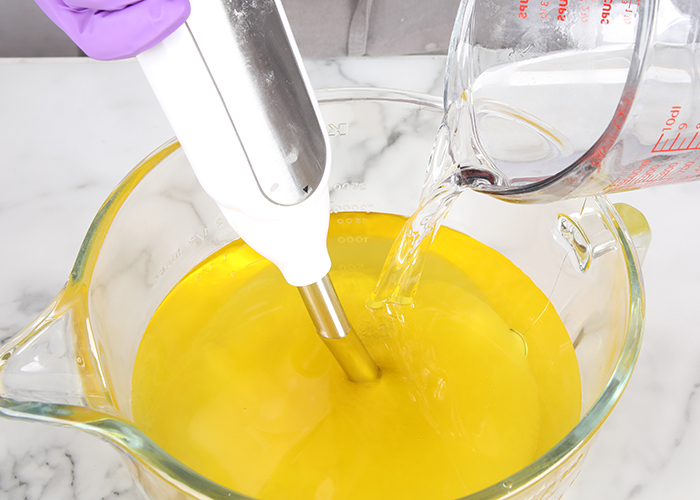 THREE: Pour off 800 mL of soap into a separate container and add 1.5 teaspoons of dispersed activated charcoal.
THREE: Pour off 800 mL of soap into a separate container and add 1.5 teaspoons of dispersed activated charcoal.
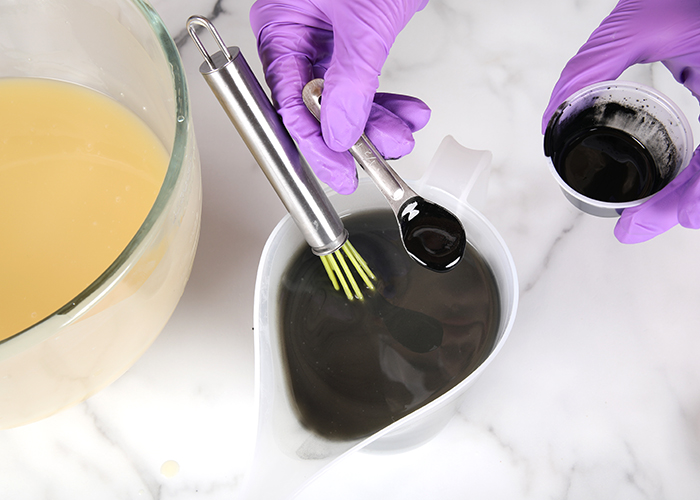 FOUR: Add a proportional amount of the measured Birchwood Oud Fragrance Oil to the gray soap – it’s okay to eyeball it.
FOUR: Add a proportional amount of the measured Birchwood Oud Fragrance Oil to the gray soap – it’s okay to eyeball it.
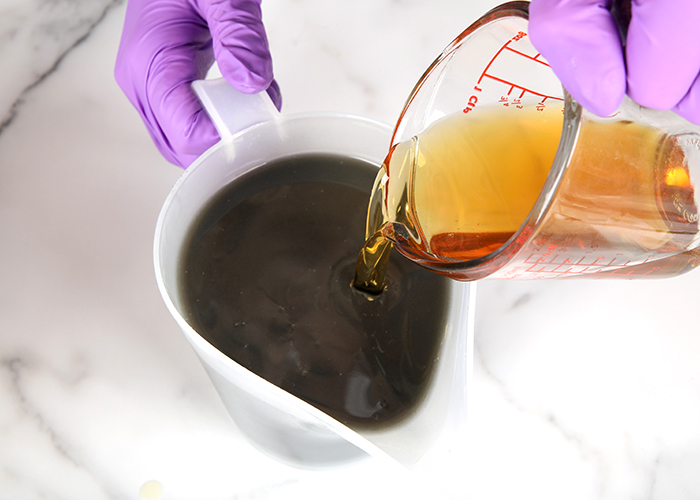 FIVE: Stick blend the soap for a few pulses to fully mix in the fragrance and colorant, and to reach a slightly thicker trace. The soap needs to be thin enough to pour and spread out in the mold evenly. You want the soap to be smooth and not hold any texture. That will give you the straightest layer.
FIVE: Stick blend the soap for a few pulses to fully mix in the fragrance and colorant, and to reach a slightly thicker trace. The soap needs to be thin enough to pour and spread out in the mold evenly. You want the soap to be smooth and not hold any texture. That will give you the straightest layer.
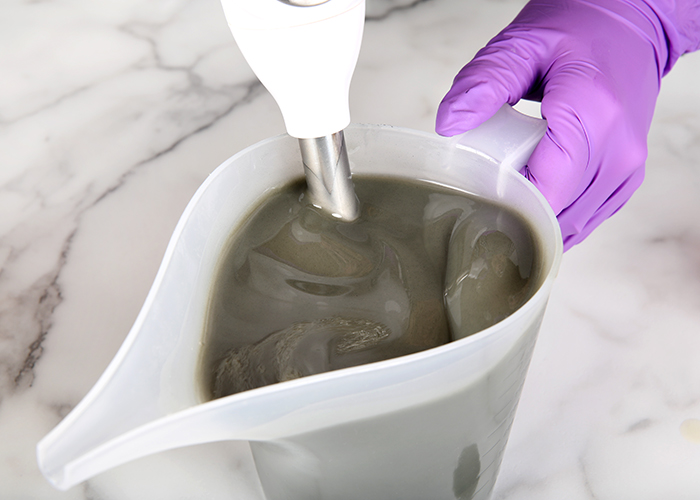 SIX: Pour all of the gray soap into the mold. Tap the mold on the counter to help get rid of bubbles and to evenly distribute the soap.
SIX: Pour all of the gray soap into the mold. Tap the mold on the counter to help get rid of bubbles and to evenly distribute the soap.
NOTE: If this layer of soap gets too thick, you may want to texture the soap with a spoon to create a purposefully uneven layer. It will still look great, just a little bit different. You can see that technique in the Lingonberry Spice Cold Process Soap or the Coastal Rain Cold Process Soap.
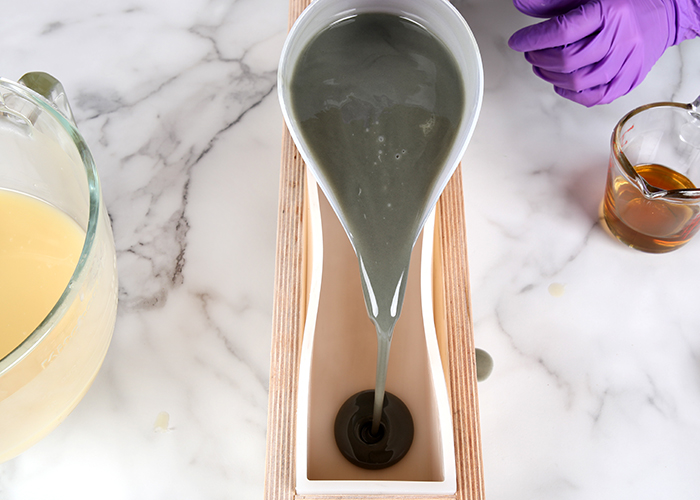 SEVEN: Place a spoonful of activated charcoal into a Powder Duster. Use your finger to gently tap the Powder Duster and apply a thin, even layer of charcoal. Work quickly but carefully – activated charcoal can be a pain to clean up. Once the entire layer of soap is covered with a layer of charcoal, set the mold aside.
SEVEN: Place a spoonful of activated charcoal into a Powder Duster. Use your finger to gently tap the Powder Duster and apply a thin, even layer of charcoal. Work quickly but carefully – activated charcoal can be a pain to clean up. Once the entire layer of soap is covered with a layer of charcoal, set the mold aside.
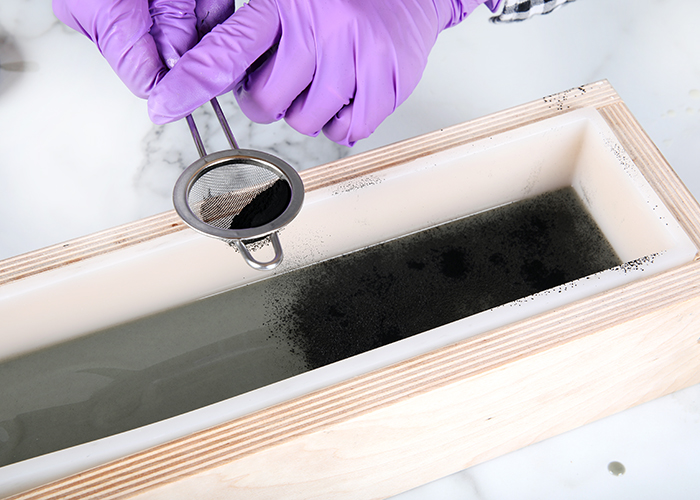 EIGHT: Section off the remaining soap into separate containers. Add the following amounts of dispersed colorants to each container, and mix them in with a whisk.
EIGHT: Section off the remaining soap into separate containers. Add the following amounts of dispersed colorants to each container, and mix them in with a whisk.
- Container A (700 mL): All dispersed titanium dioxide
- Container B (400 mL): Remaining dispersed activated charcoal
- Container C (400 mL): 1/4 teaspoon dispersed Green Chrome Oxide + 1/2 teaspoon dispersed Evergreen Mica
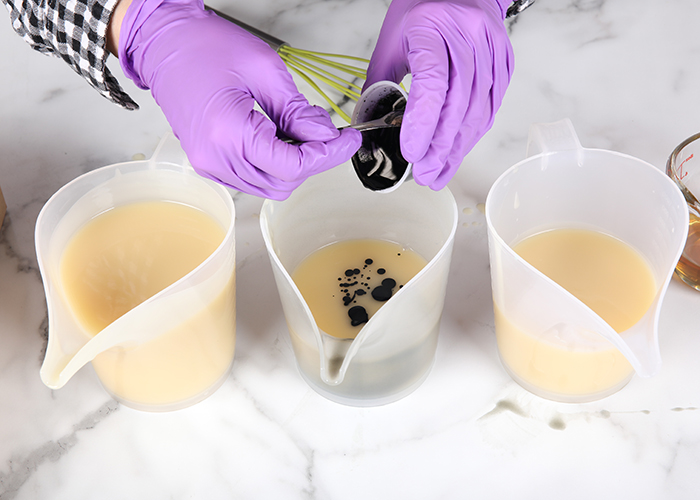
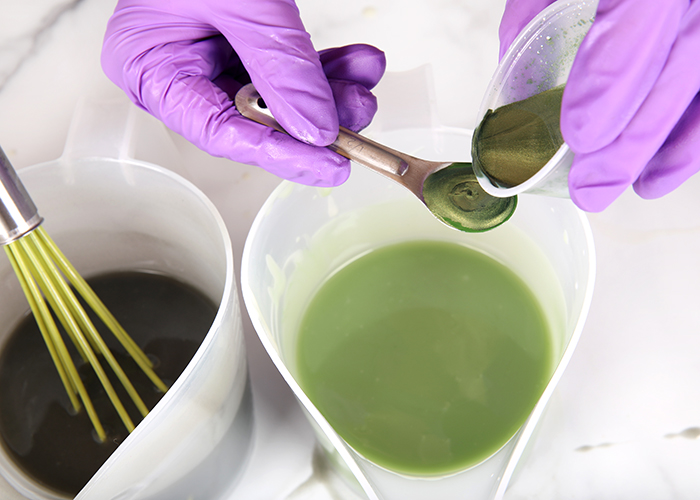 NINE: Pour the remaining Birchwood Oud Fragrance Oil into the three containers proportionally – it’s okay to eyeball it. Use a whisk to fully mix in the fragrance.
NINE: Pour the remaining Birchwood Oud Fragrance Oil into the three containers proportionally – it’s okay to eyeball it. Use a whisk to fully mix in the fragrance.
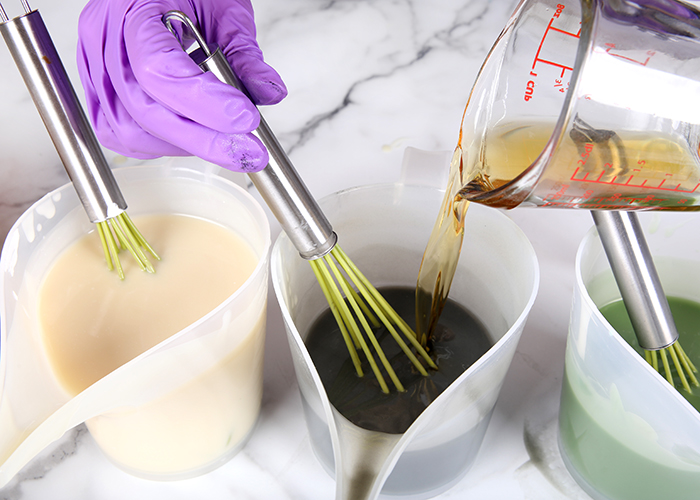 TEN: Begin pouring white soap into the large bowl, allowing it to run down the side. As you pour, count 1, 2, 3, 4 to keep each pour consistent. The exact amount of soap you pour at a time is up to you. The more soap you pour into the bowl at a time, the fewer total layers there will be.
TEN: Begin pouring white soap into the large bowl, allowing it to run down the side. As you pour, count 1, 2, 3, 4 to keep each pour consistent. The exact amount of soap you pour at a time is up to you. The more soap you pour into the bowl at a time, the fewer total layers there will be.
NOTE: We tilted the bowl while pouring to help the soap run down the side of the bowl more. This could make pouring trickier. If it feels too unstable, leave the bowl level on the table. Just be very careful when pouring that the soap doesn’t drop into the soap and break through to the layers in the bowl.
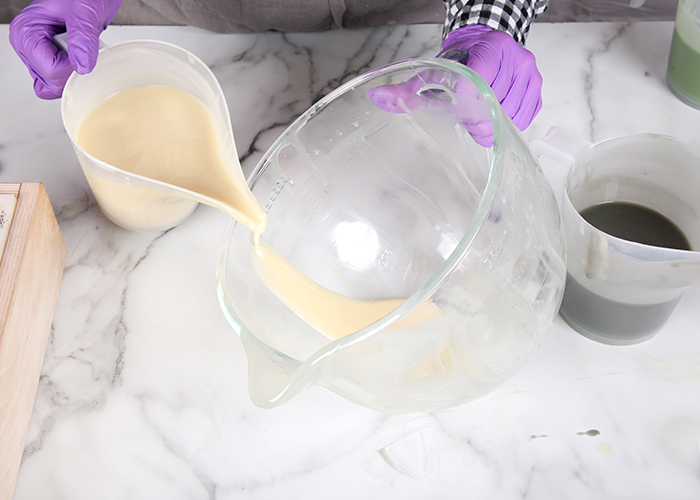 ELEVEN: Continue pouring the soap into the bowl in the pattern of white, black, white, green. Counting while pouring helps keep the pours consistent.
ELEVEN: Continue pouring the soap into the bowl in the pattern of white, black, white, green. Counting while pouring helps keep the pours consistent.
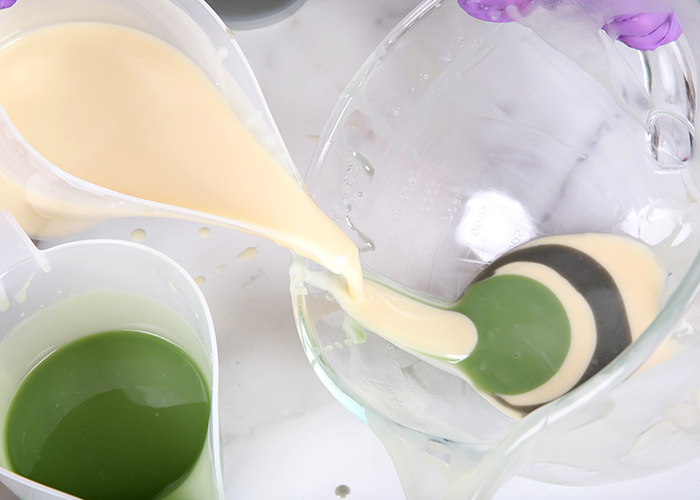
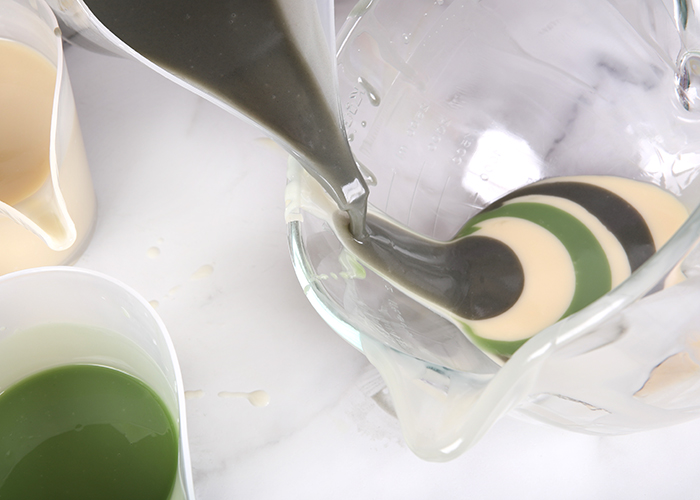
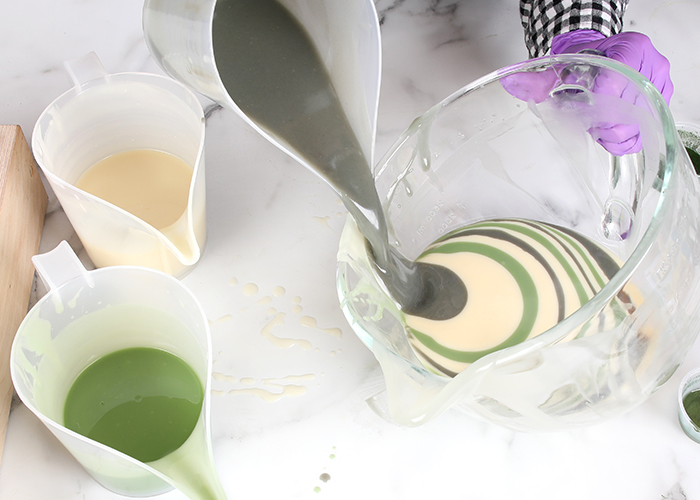
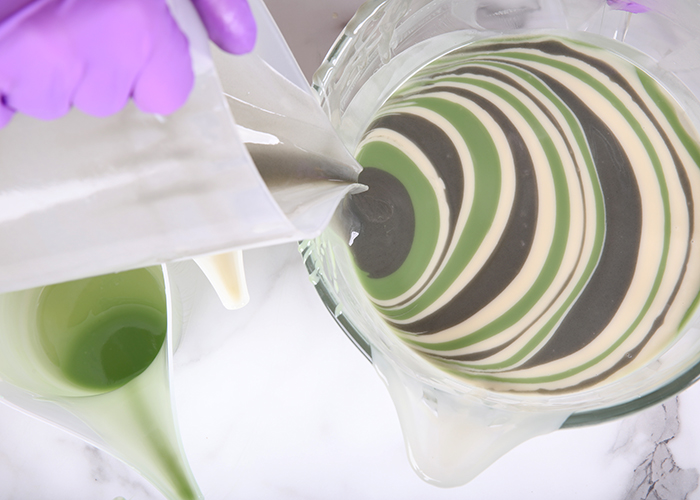 TWELVE: Once all of the soap is in the large bowl, begin to pour the soap into a corner of the mold. Be very careful – you don’t want the soap to break through the layer below.
TWELVE: Once all of the soap is in the large bowl, begin to pour the soap into a corner of the mold. Be very careful – you don’t want the soap to break through the layer below.
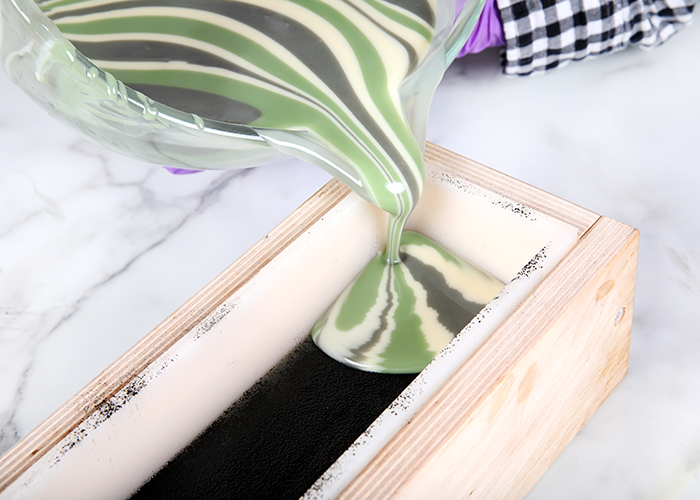
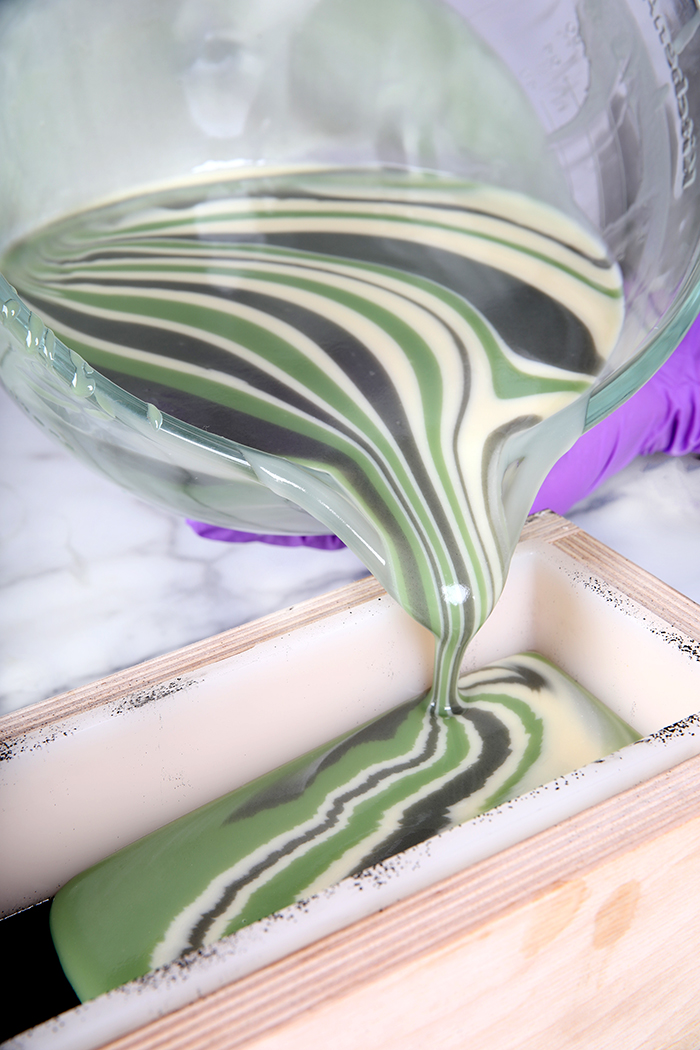 THIRTEEN: As the mold begins to fill up, slowly move the bowl down the length of the mold while pouring.
THIRTEEN: As the mold begins to fill up, slowly move the bowl down the length of the mold while pouring.
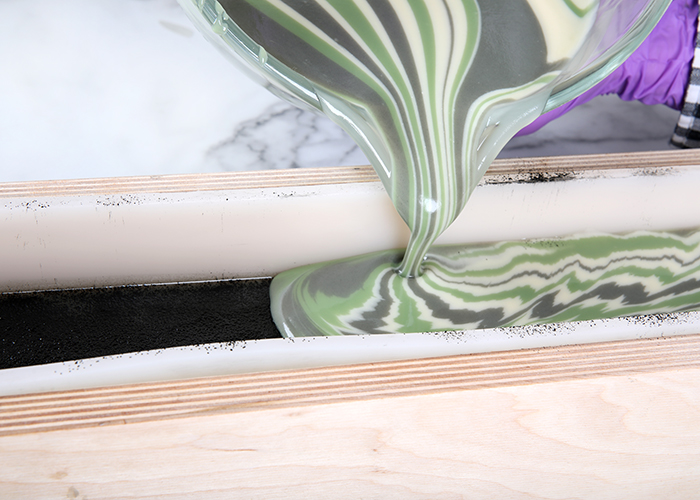
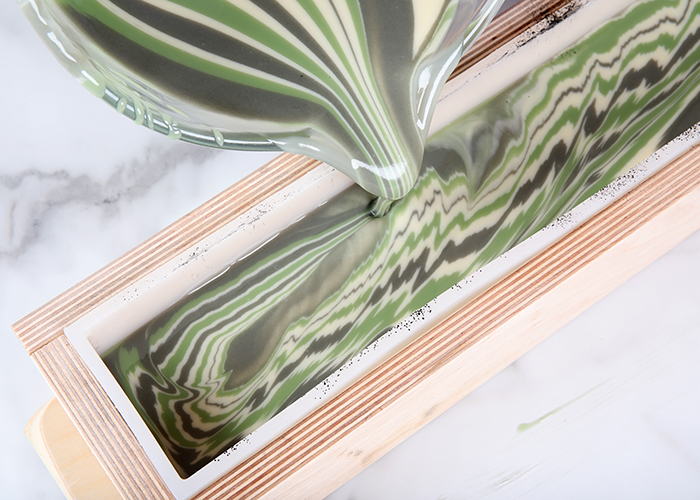 FOURTEEN: Once there is about 1/4 of the soap left to pour, begin moving the bowl down the length of the mold more and more to create long stripes. Try to pour as straight as you can.
FOURTEEN: Once there is about 1/4 of the soap left to pour, begin moving the bowl down the length of the mold more and more to create long stripes. Try to pour as straight as you can.
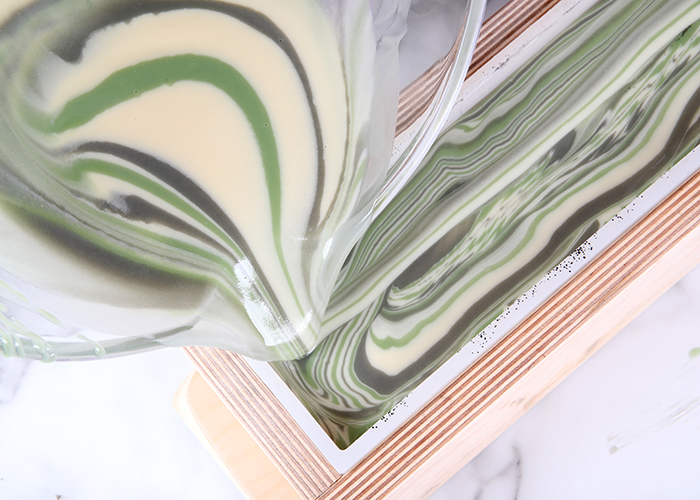
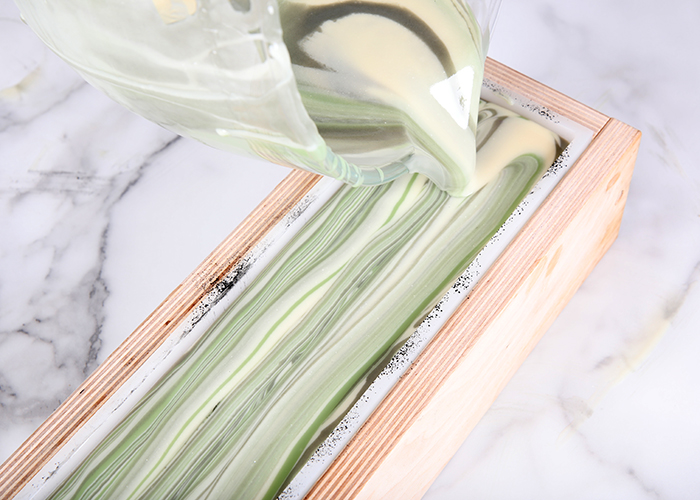 FIFTEEN: Once all the soap has been poured, tap the mold on the counter to get rid of bubbles. Spritz the top with 99% isopropyl alcohol to prevent soda ash. To help the colors pop, we forced the soap through gel phase by placing it on a heating pad set to medium-high for about 1-2 hours. We covered the mold using cardboard and a towel to insulate for 24 hours.
FIFTEEN: Once all the soap has been poured, tap the mold on the counter to get rid of bubbles. Spritz the top with 99% isopropyl alcohol to prevent soda ash. To help the colors pop, we forced the soap through gel phase by placing it on a heating pad set to medium-high for about 1-2 hours. We covered the mold using cardboard and a towel to insulate for 24 hours.
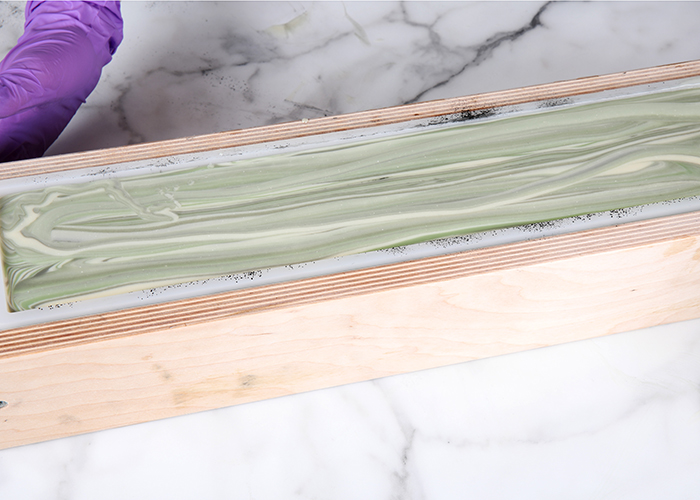 SIXTEEN: Remove the soap from the mold after 1-3 days (depending if you used sodium lactate or not). Cut the soap into bars. After the bars were cut, we used the Soap Shaver to smooth the tops. Adjust the shaver to only slice off a small amount and quickly slide the soap over the blade. Continue to do this until you’re happy with the look of the top. Allow the soap to cure for 4-6 weeks and enjoy!
SIXTEEN: Remove the soap from the mold after 1-3 days (depending if you used sodium lactate or not). Cut the soap into bars. After the bars were cut, we used the Soap Shaver to smooth the tops. Adjust the shaver to only slice off a small amount and quickly slide the soap over the blade. Continue to do this until you’re happy with the look of the top. Allow the soap to cure for 4-6 weeks and enjoy!
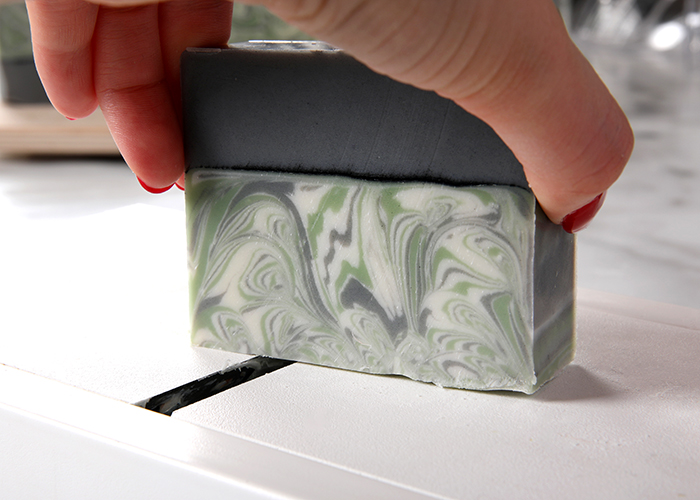
The two bars in the top left haven’t been shaved while the three bars on the right have. You’ll notice the Soap Shaver took off a bit of soda ash, which made the colors look more vibrant. The smooth and even texture also looks more polished.
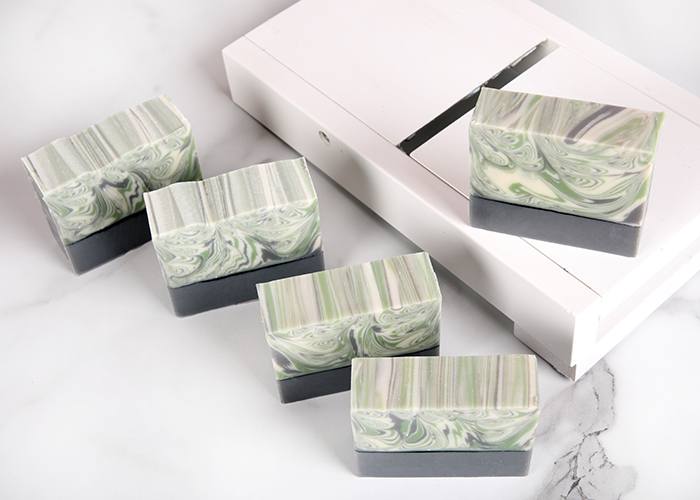
- 5 Pound Mold with Sliding Bottom
- Silicone Liner for 5 lb. Wood Mold
- 13.8 oz. Coconut Oil (25%)
- 2.8 oz. Jojoba Oil (5.1%)
- 5.5 oz. Lingonberry Seed Oil (10%)
- 2.8 oz. Chia Seed Oil (5%)
- 16.5 oz. Olive Oil (29.9%)
- 13.7 oz. Palm Oil (24.9%)
- 7.6 oz. Sodium Hydroxide Lye
- 16.4 oz. Distilled Water (10% water discount)
- 3.5 oz. Birchwood Oud Fragrance Oil
- Titanium Dioxide
- Activated Charcoal
- Green Chrome Oxide Pigment
- Evergreen Mica
- Slowly and carefully add 7.6 ounces of lye to 16.4 ounces of distilled water. Gently stir until the lye has fully dissolved. Set it aside to cool. If you’d like a harder bar of soap that releases faster from the mold, you can add sodium lactate to the cooled lye water. Use 1 teaspoon of sodium lactate per pound of oils in the recipe. For this recipe, you’d add 3.5 teaspoons sodium lactate.
- Melt and combine 13.8 ounces of coconut oil, 2.8 ounces of jojoba oil, 5.5 ounces of lingonberry seed oil, 2.8 ounces of chia seed oil, 16.5 ounces of olive oil, and 13.7 ounces of palm oil (completely melt the entire container of palm oil before portioning) into a large mixing bowl. Once the lye water and the oils have cooled to 130 degrees F or below (and are ideally within 10 degrees of each other), add the lye water to the oils and stick blend the mixture to a very thin trace.
- Pour off 800 mL of soap into a separate container and add 1.5 teaspoons of dispersed activated charcoal.
- Add a proportional amount of the measured Birchwood Oud Fragrance Oil to the gray soap – it’s okay to eyeball it.
- Stick blend the soap for a few pulses to fully mix in the fragrance and colorant, and to reach a slightly thicker trace. The soap needs to be thin enough to pour and spread out in the mold evenly. You want the soap to be smooth and not hold any texture. That will give you the straightest layer.
- Pour all of the gray soap into the mold. Tap the mold on the counter to help get rid of bubbles and to evenly distribute the soap. NOTE: If this layer of soap gets too thick, you may want to texture the soap with a spoon to create a purposefully uneven layer. It will still look great, just a little bit different.
- Place a spoonful of activated charcoal into a Powder Duster. Use your finger to gently tap the Powder Duster and apply a thin, even layer of charcoal. Work quickly but carefully – activated charcoal can be a pain to clean up. Once the entire layer of soap is covered with a layer of charcoal, set the mold aside.
- Section off the remaining soap into separate containers. Add the following amounts of dispersed colorants to each container, and mix them in with a whisk.
Container A (700 mL): All dispersed titanium dioxide
Container B (400 mL): Remaining dispersed activated charcoal
Container C (400 mL): ¼ teaspoon dispersed Green Chrome Oxide + ½ teaspoon dispersed Evergreen Mica - Pour the remaining Birchwood Oud Fragrance Oil into the three containers proportionally – it’s okay to eyeball it. Use a whisk to fully mix in the fragrance.
- Begin pouring white soap into the large bowl, allowing it to run down the side. As you pour, count 1, 2, 3, 4 to keep each pour consistent. The exact amount of soap you pour at a time is up to you. The more soap you pour into the bowl at a time, the fewer total layers there will be. NOTE: We tilted the bowl while pouring to help the soap run down the side of the bowl more. This could make pouring trickier. If it feels too unstable, leave the bowl level on the table. Just be very careful when pouring that the soap doesn’t drop into the soap and break through to the layers in the bowl.
- Continue pouring the soap into the bowl in the pattern of white, black, white, green. Counting while pouring helps keep the pours consistent.
- Once all of the soap is in the large bowl, begin to pour the soap into a corner of the mold. Be very careful – you don’t want the soap to break through the layer below.
- As the mold begins to fill up, slowly move the bowl down the length of the mold while pouring.
- Once there is about ¼ of the soap left to pour, begin moving the bowl down the length of the mold more and more to create long stripes. Try to pour as straight as you can.
- Once all the soap has been poured, tap the mold on the counter to get rid of bubbles. Spritz the top with 99% isopropyl alcohol to prevent soda ash. To help the colors pop, we forced the soap through gel phase by placing it on a heating pad set to medium-high for about 1-2 hours. We covered the mold using cardboard and a towel to insulate for 24 hours.
- Remove the soap from the mold after 1-3 days (depending if you used sodium lactate or not). Cut the soap into bars. After the bars were cut, we used the Soap Shaver to smooth the tops. Adjust the shaver to only slice off a small amount and quickly slide the soap over the blade. Continue to do this until you’re happy with the look of the top. Allow the soap to cure for 4-6 weeks and enjoy!
- The two bars in the top left haven’t been shaved while the three bars on the right have. You’ll notice the Soap Shaver took off a bit of soda ash, which made the colors look more vibrant. The smooth and even texture also looks more polished.
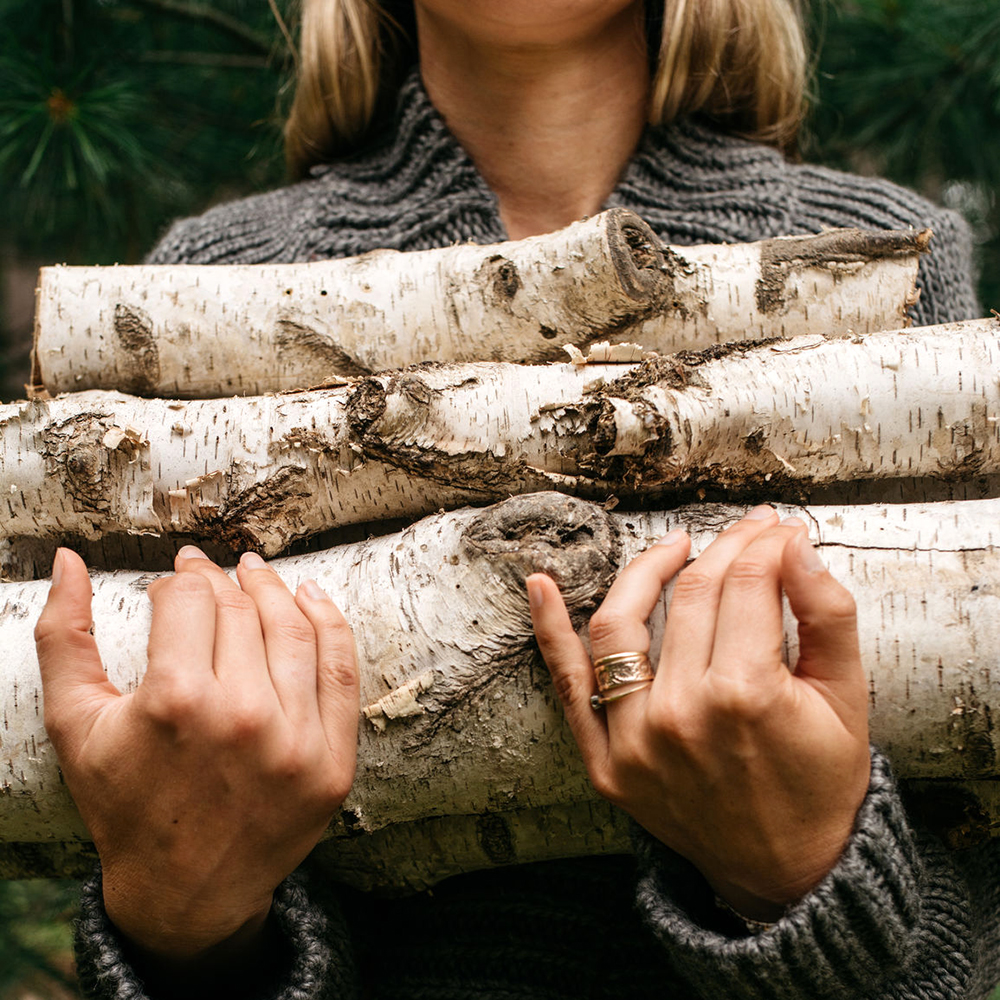

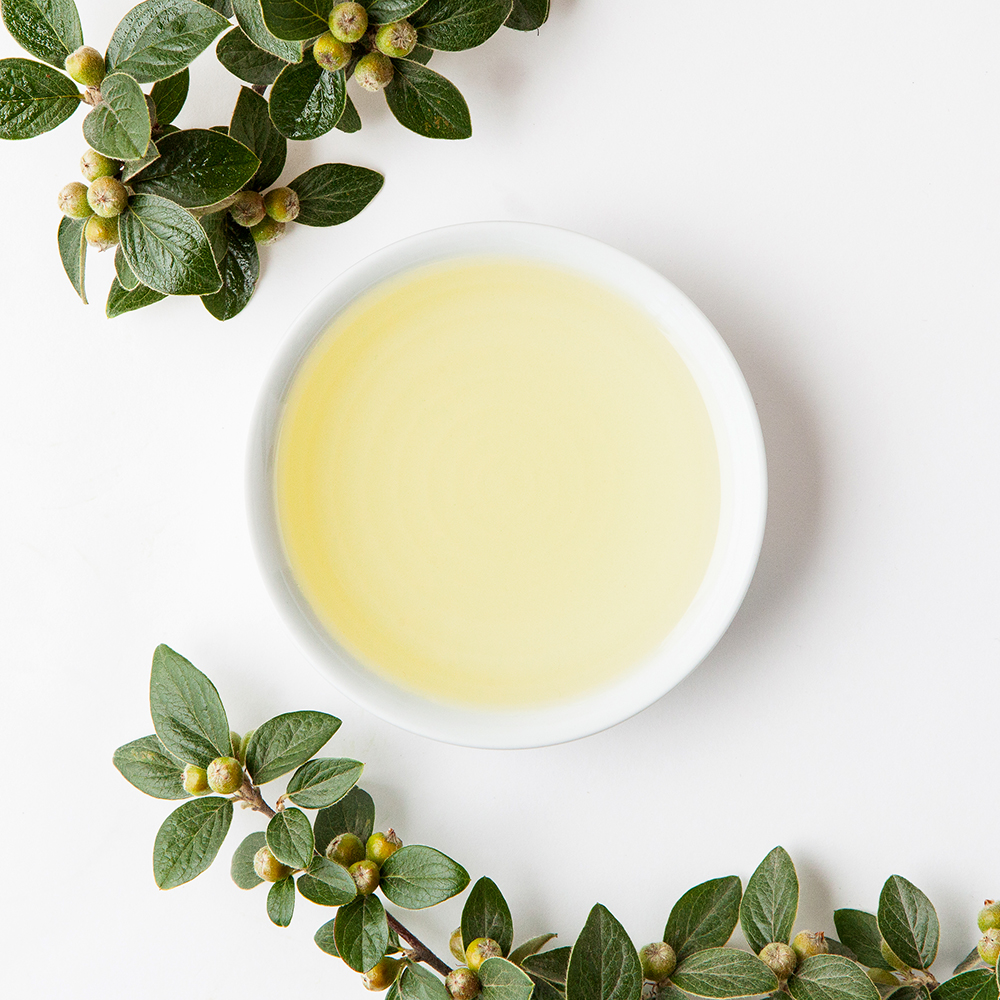
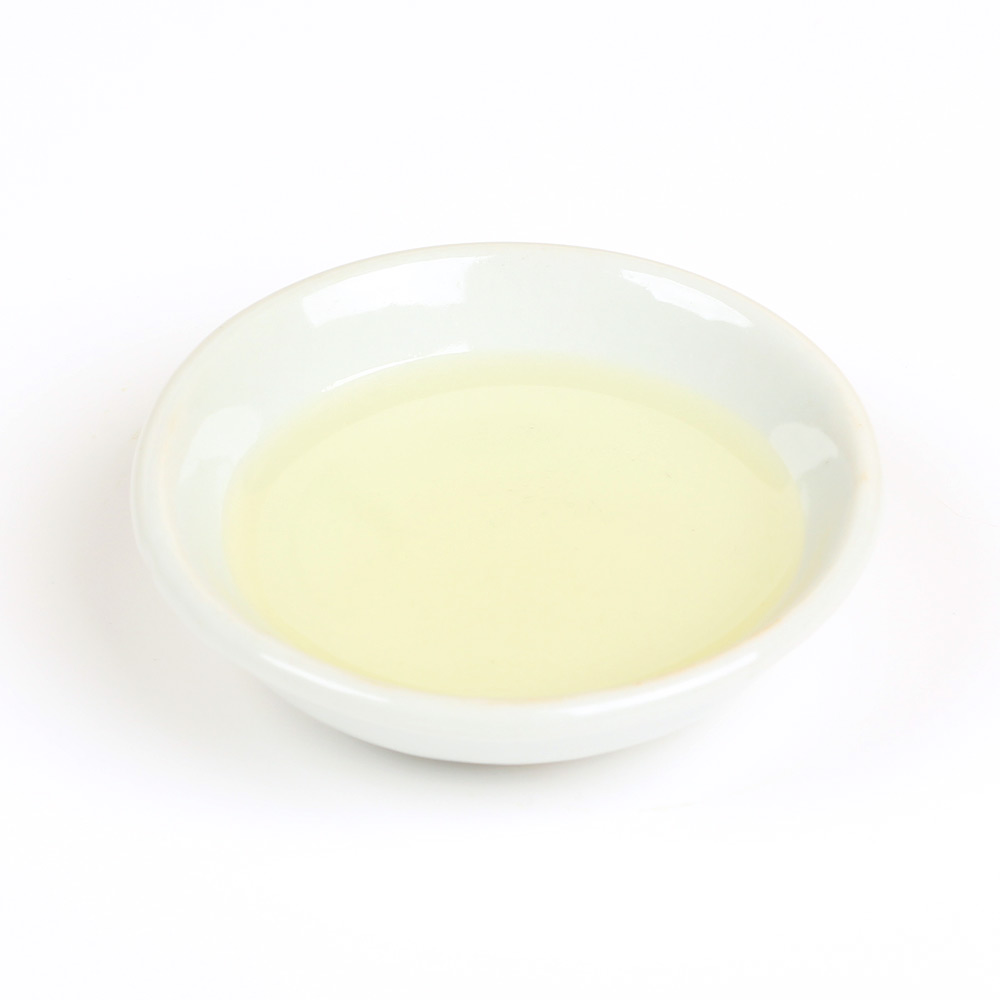
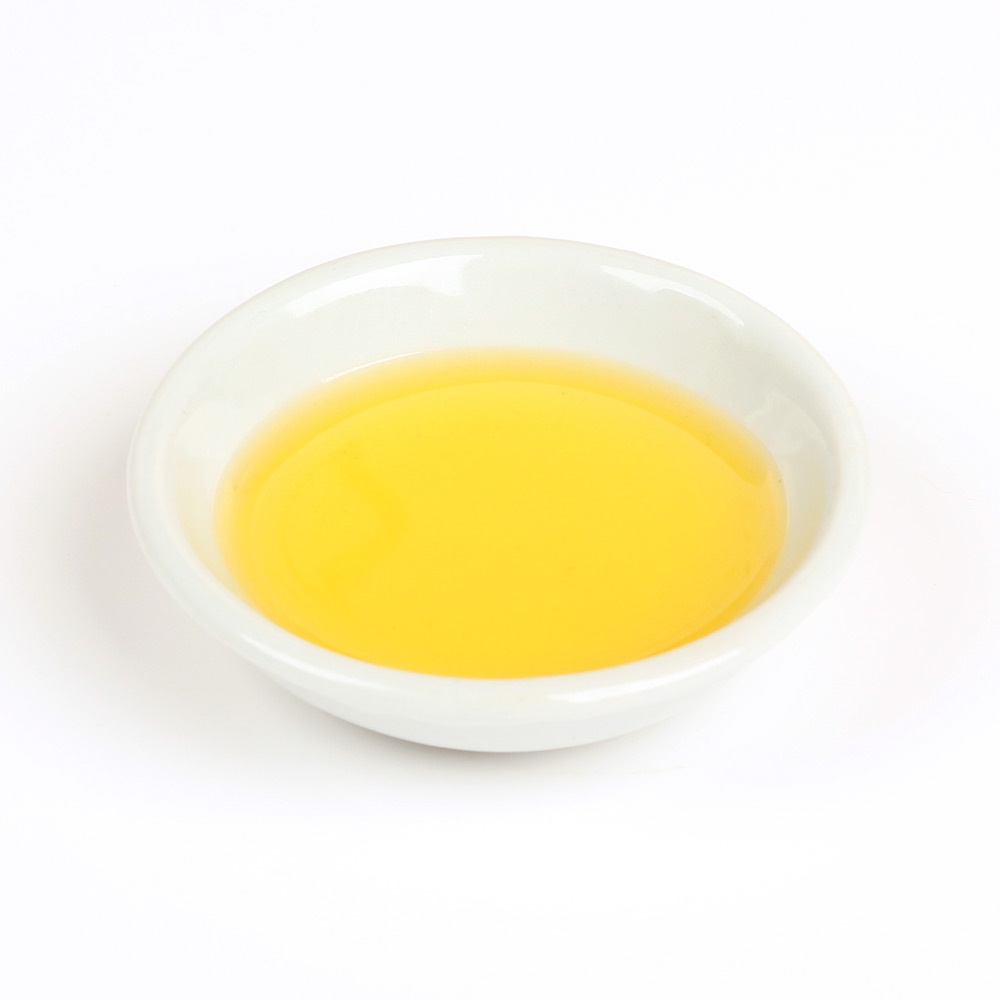
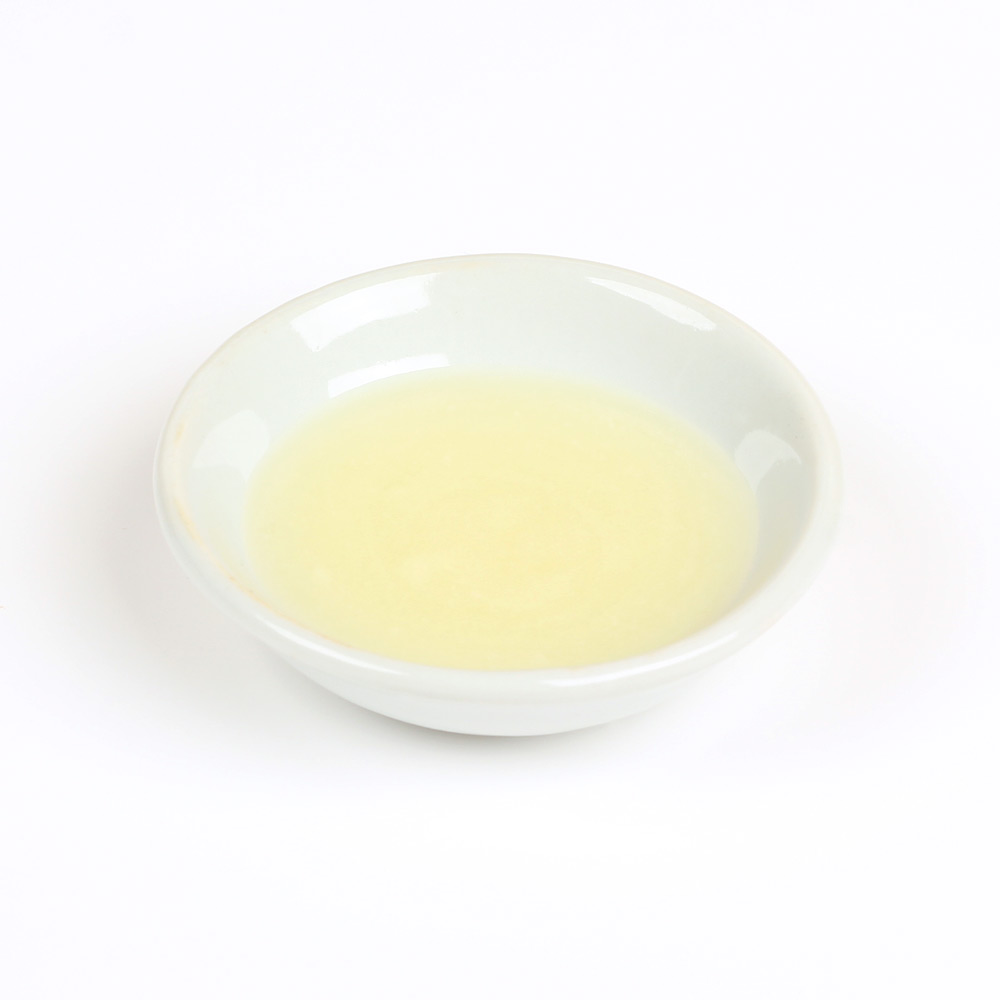
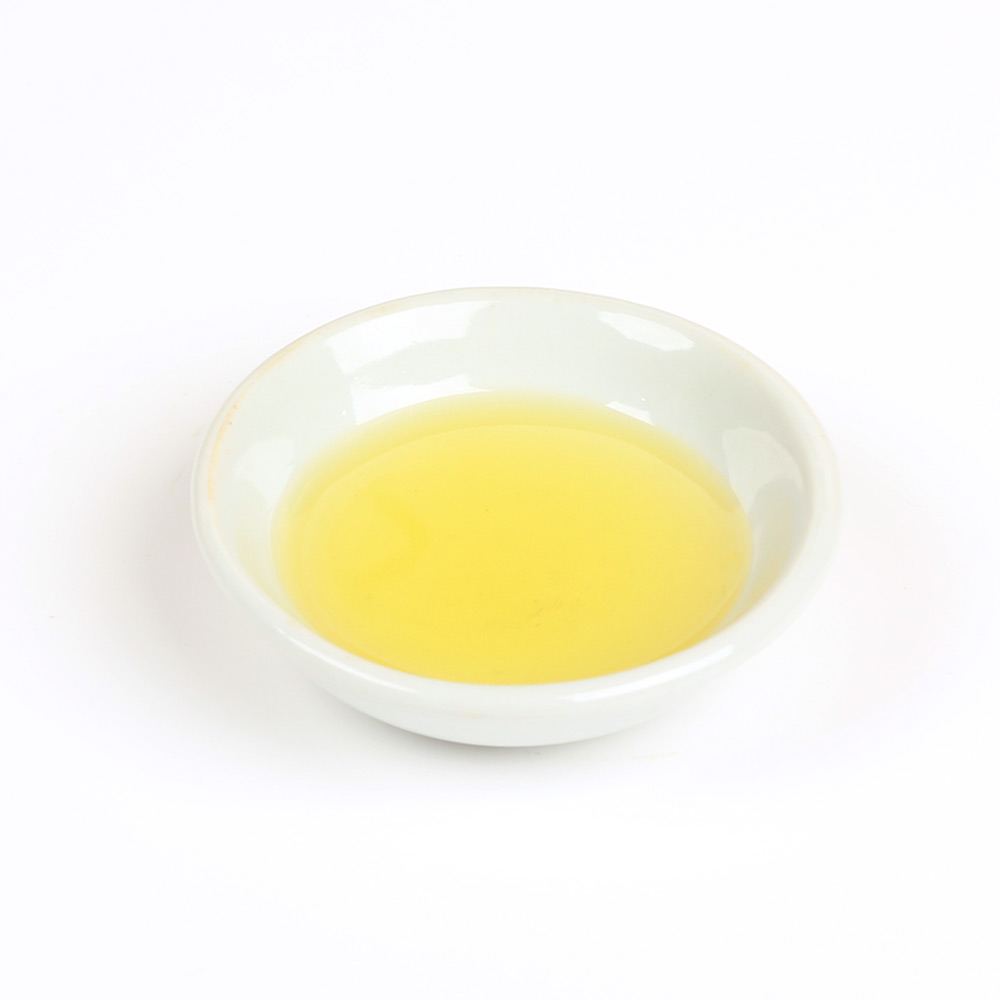
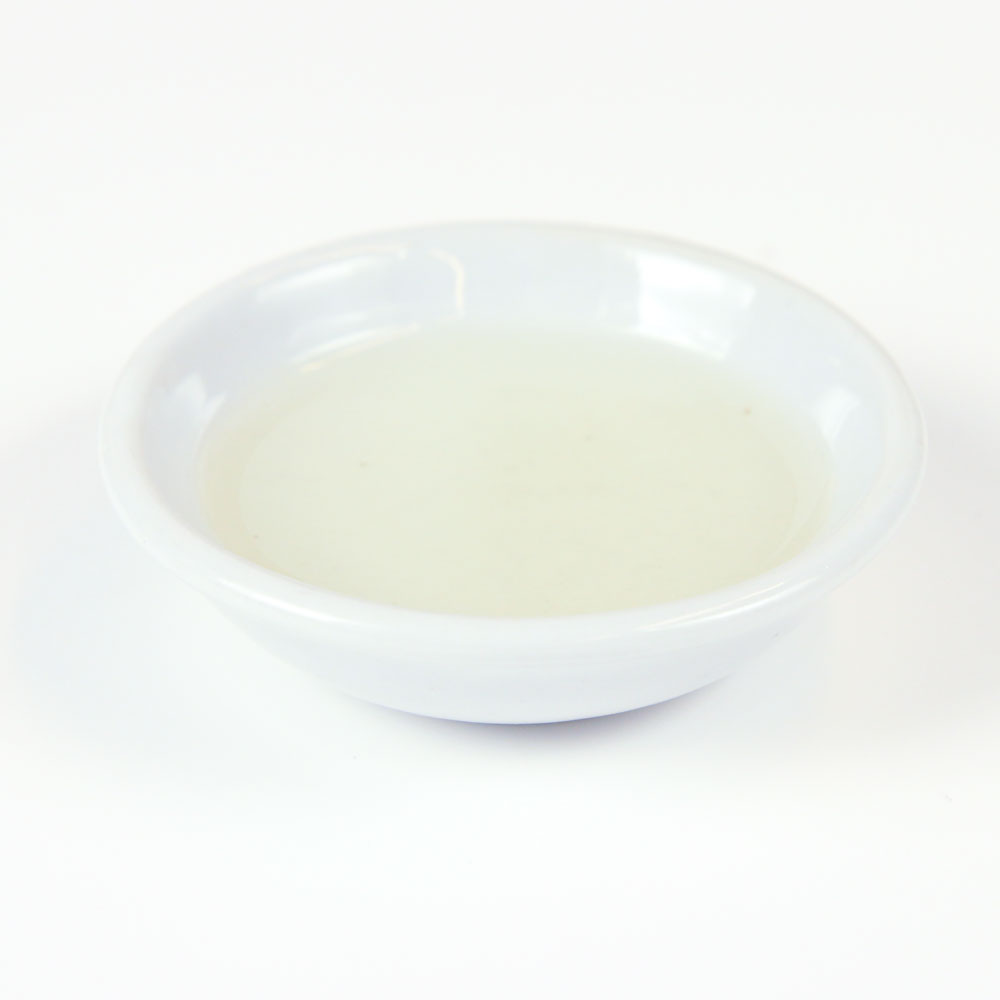
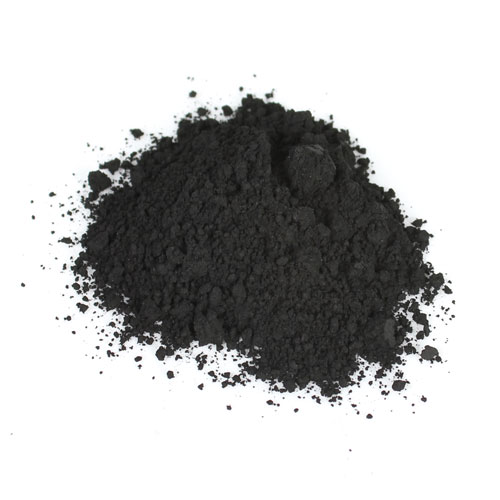

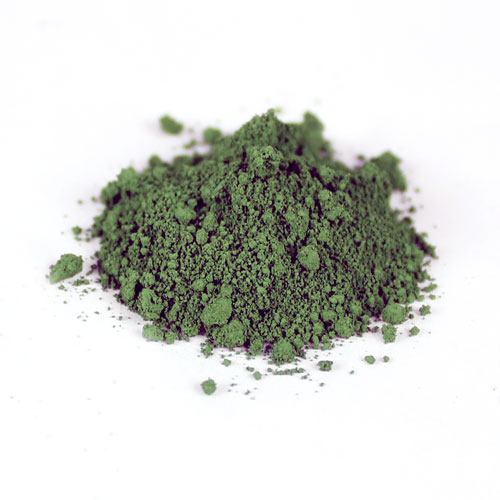
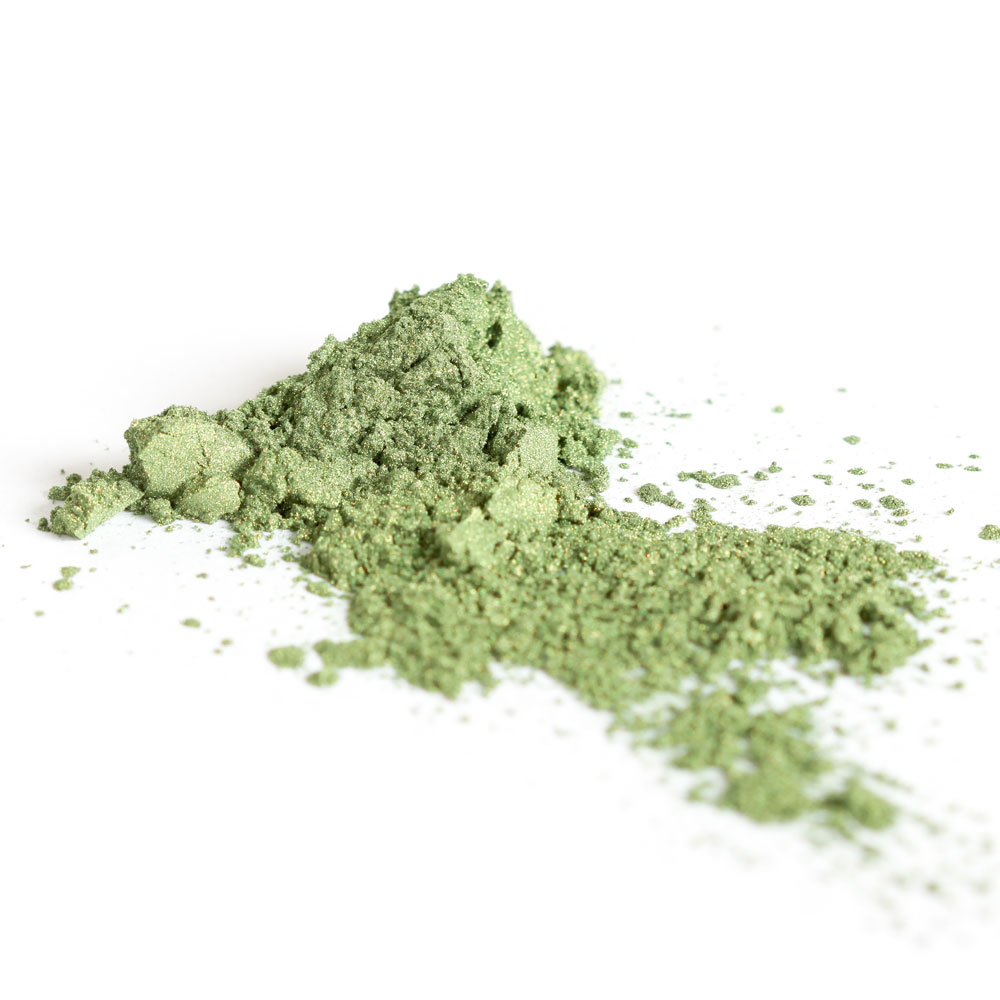
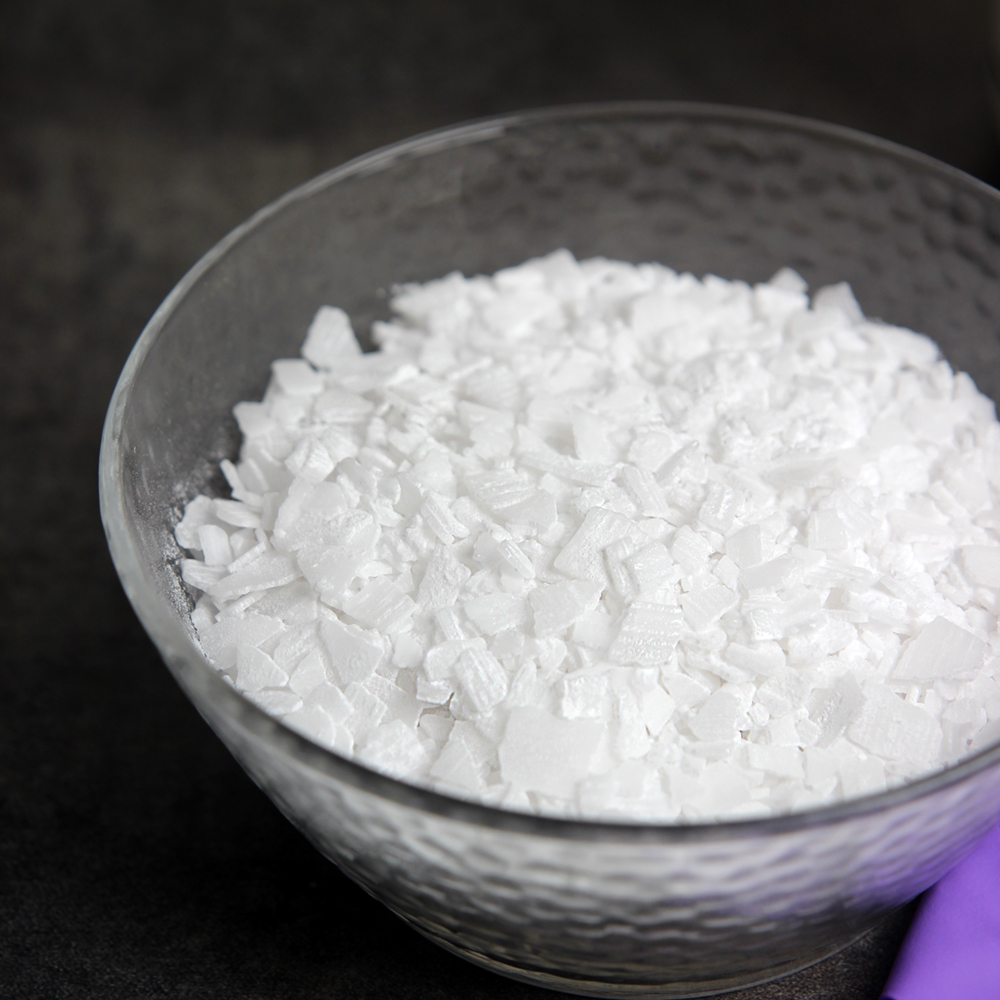
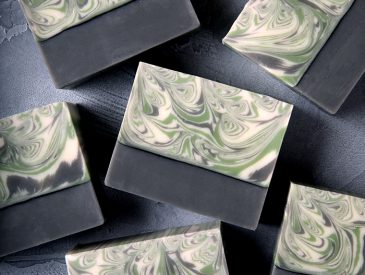


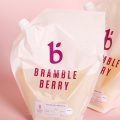
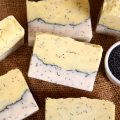
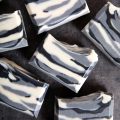
Very beautiful soap.
Thanks for sharing this.
Is it possible to make this soap not including?
2.8 oz. Jojoba Oil (5.1%)
5.5 oz. Lingonberry Seed Oil (10%)
2.8 oz. Chia Seed Oil (5%)
and simply just increase the amounts of the remaining oils.
Yes you can do that. The soap will most likely just have a different feel and hardness. I would use each oil at 33% and then 34% for the Olive Oil. You will want to run your new recipe through the Lye Calculator for the new Lye / Water amounts.
Hi, I just made this using the adjusted ingredients above, but my trace was way too thick, do you know how this could be? The second I poured the lye water into the oils it was too thick so over mixing isn’t the case.
Can this technique be done using melt and pour soap?
You can do the layer really easy but you won’t be able to get the same type of swirl. This recipe here would be the closest you can get with melt and pour: https://www.soapqueen.com/bath-and-body-tutorials/seascape-melt-pour-soap-tutorial/
Thank you Chloe! I think I will try the Seascape tutorial, I already have everything I need.
Hi!
I made this last weekend and just cut it. It was still pretty soft, even after almost a week in the mold and using sodium lactate. Now that it’s cut, I’m noticing a reddish ring in the soap right around the inside. Like maybe it didn’t go all the way through gel phase and the red is the line between where it did and didn’t. Is that possible? I’ve seen the dreaded orange spots before, but this feels different, or maybe some of the colorant is making the orange look red? I used all fresh oils as far as I know. I date everything with my order date and it was all within the usage suggestions. Do you know what else it could be? Any hope of it going away during curing? Feel free to contact me by email and I can send pictures.
That is super strange! I would love to see pictures and help with this. Please email them to [email protected]
I just checked after curing for a few weeks and it’s mostly gone away!! This was by far the most challenging recipe I’ve attempted so far. They are far from perfect but I learned a ton and they are still so beautiful!
I’m so happy to hear that! Thanks for letting us know.
I am a beginner. I am seeing some concern regarding titanium dioxide and its safety. Is there a non-controversial substitute. Is it possible to just not add any colorant to that portion and still get the visual effecg?
You can definitely just not add anything to that part of the recipe, but soap tends to be a bit yellow tinted so it won’t be quite as white as the bars you see here.
This is realy help full thank you so much for sharing such a brilliant information
Here’s how you could resize the recipe to fit a 10in silicone mold and use less expensive oils:
225 g coconut oil (25%)
45.9 g jojoba oil (5.1%)
90 g avocado oil (10%)
45.9 g sweet almond oil (5.1%)
269.1 g olive oil (29.9%)
224.1 g palm oil (24.9%)
What can I use to replace the lingonberry and chia seed oil with? 8 don’t have them. Thank you
I would use Green Tea Seed Oil for the Chia Seed and Avocado Oil for the Lingonberry Oil. When making any substitutions make sure yourun the recipe through our lye calculator again.
Very beautiful soap. Do you cover and insulate while it’s on the heating pad ?
While on the heating pad we also kept the soap covered using cardboard and a towel, then keep it insulated 24 hours after the heating pad is turned off.
This is a very expensive recipe! You are suggesting that with the Lingoberry oil, the chia seed oil and the jojoba oil, not to mention the fragrance, that we spend $47.11 on those products alone. That is not including the remainder of the ingredients. You’d definitely have to be in the Royal Family to make this soap. When purchasing all of the ingredients, you are looking at $15.00 per bar? This is no longer an enjoyable hobby with those prices.
When I make a soap I see on here that I love with expensive ingredients I usually use my own recipe or replace the expensive oils with another oil with almost the same properties and less expensive. Something I have on hand. For this one I would probably buy the Lingonberry oil and replace the chia and jojoba oils
Avid soap makers may very well have all or most of these ingredients on hand. When you consider the cost of the portion of materials you actually use, it is not as exorbitant as you make it out to be. Also, there are a good number of people that can and will spend a significant amount of money on something they enjoy doing, so why wouldn’t a soaping company make some recipes available to those that wish to incorporate finer ingredients? Bramble Berry has dozens upon dozens of recipes catering to those with lower budgets.
Martina, I’m with you 100%! I love SoapQueen, but sometimes I think the SQ team makes the recipes as expensive as possible with 5lb mold recipes and expensive oils in order to boost their sales. So I’m glad to see someone finally voicing this concern.
I plan to make this soap but I will definitely be reducing the expense by resizing to fit the 10in silicone mold, substituting the chia and lingonberry oil, and using a fragrance I already have on hand.
Martina, Chloe commented above that you could substitute the chia seed oil with green tea oil and the lingonberry oil with avocado oil.
I happen to have avocado oil on hand but not green tea oil.
Going by the info in SoapQueen’s post on substituting oils — you can replace the chia seed oil with avocado oil or sweet almond oil.
Hope this info helps!
I recently graduated myself from the cavity mold I first purchased up to a loaf mold and am having so much fun playing with swirls and enjoying the ease of working with a loaf mold. I will have to try this method sometime.
By the way, after removing the cost of the mold and the liner. The cost per bar of soap was about $5.40 for ingredients, and some of those mostly colorants could be used in other products which would lower the cost per bar. Obviously, there are other factors. One of these days, I want to try these pricier specialty oils. I just wanted to offer this perspective.